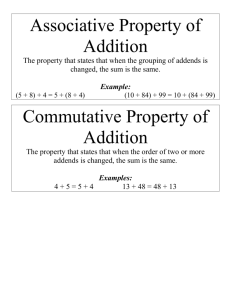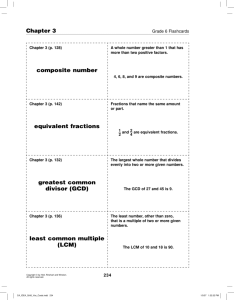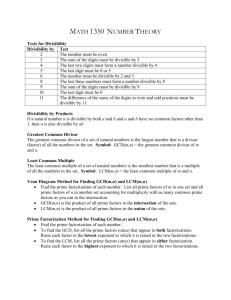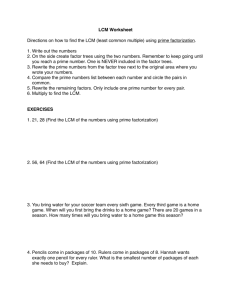Number Theory
advertisement
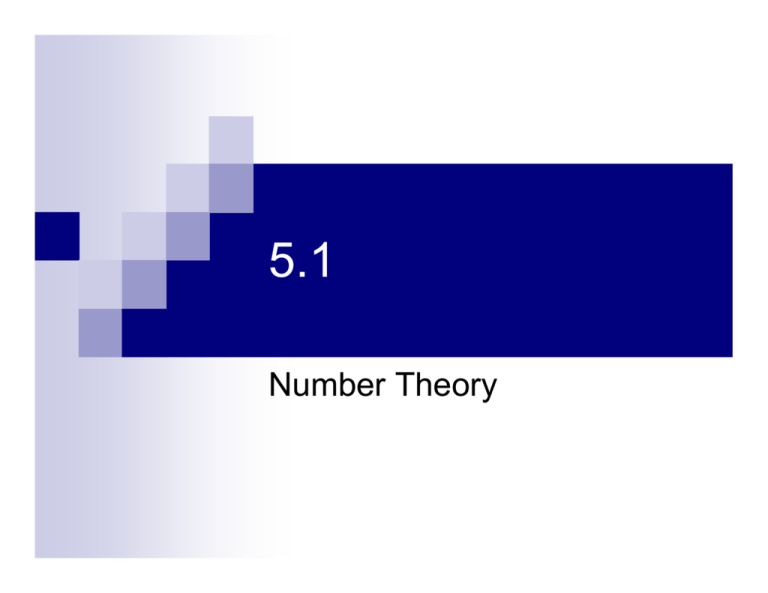
5.1
Number Theory
Number Theory
The study of numbers and their properties.
The numbers we`use to count are called
the Natural Numbers
or Counting
Numbers.
` = {1,2,3,4,5,...}
Factors
The natural numbers that are multiplied
together to equal another natural number
are called factors of the product.
Example:
The factors of 24 are 1, 2, 3, 4, 6, 8, 12
and 24.
Divisors
If a and b are natural numbers and the
quotient of b divided by a has a remainder
of 0, then we say that a is a divisor of b or
a divides b.
Prime and Composite Numbers
A prime number is a natural number
greater than 1 that has exactly two factors
(or divisors), itself and 1.
A composite number is a natural number
that is divisible by a number other than
itself and 1.
The number 1 is neither prime nor
composite, it is called a unit.
Rules of Divisibility
OMIT THIS PART
The Fundamental Theorem of
Arithmetic
Every composite number can be written as
a unique product of prime numbers.
This unique product is referred to as the
prime factorization of the number.
Finding Prime Factorizations
Branching Method:
Select any two numbers whose product is
the number to be factored.
If the factors are not prime numbers, then
continue factoring each number until all
numbers are prime.
Example of branching method
3190
0
319
0 2
11
29
2
10
0 2
5
2
Therefore, the prime factorization of
3190 = 2 • 5 • 11 • 29
Division Method
1. Divide the given number by the smallest prime
number by which it is divisible.
2. Place the quotient under the given number.
3. Divide the quotient by the smallest prime
number by which it is divisible and again
record the quotient.
4. Repeat this process until the quotient is a
prime number.
Example of division method
Write the prime factorization of 663.
3 663
13 221
17
The final quotient 17, is a prime number, so
we stop. The prime factorization of 663 is
3 •13 •17
Greatest Common Divisor
The greatest common divisor (GCD) of a
set of natural numbers is the largest
natural number that divides (without
remainder) every number in that set.
Finding the GCD
Determine the prime factorization of
each number.
Find each prime factor with smallest
exponent that appears in each of the
prime factorizations.
Determine the product of the factors
found in step 2.
Example (GCD)
Find the GCD of 63 and 105.
63 = 32 • 7
105 = 3 • 5 • 7
Smallest exponent of each factor:
3 and 7
So, the GCD is 3 • 7 = 21
Least Common Multiple
The least common multiple (LCM) of a set
of natural numbers is the smallest natural
number that is divisible (without
remainder) by each element of the set.
Finding the LCM
Determine the prime factorization of each
number.
List each prime factor with the greatest
exponent that appears in any of the
prime factorizations.
Determine the product of the factors
found in step 2.
Example (LCM)
Find the LCM of 63 and 105.
63 = 32 • 7
105 = 3 • 5 • 7
Greatest exponent of each factor:
32, 5 and 7
So, the GCD is 32 • 5 • 7 = 315
Example of GCD and LCM
Find the GCD and LCM of 48 and 54.
Prime factorizations of each:
= 2 • 2 • 2 • 2 • 3 = 24 • 3
54 = 2 • 3 • 3 • 3 = 2 • 33
48
GCD = 2 • 3 = 6
LCM = 24 • 33 = 432
Next Steps
Read Examples 2-7
Work Problems in text on p. 216
15-20, all; 35-55, odds; 63-67, all
Do Online homework corresponding to this
section

